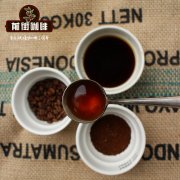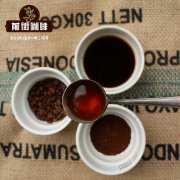Arabica beans turned out to be small fruit coffee? Arabica Coffee and Arabica Coffee

Professional coffee knowledge exchange more coffee bean information please follow the coffee workshop (Wechat official account cafe_style)
Small fruit coffee (scientific name: Coffea arabica), also known as Arabica coffee, Arabica coffee, is a species of Rubiaceae coffee, is the most traditional coffee variety. Originally from East Africa, coffee was monopolized by the Arab world for a long time before the 15th century, so it was called "Arabian coffee" by Europeans.
It turns out that all the commercial coffee in the world is small fruit coffee, but it was only at the end of the 19th century that growers began to look for other disease-resistant varieties. At present, small fruit coffee is still the main variety of coffee, accounting for about 3% and 4% of the world's total coffee output. It is mainly grown in Latin American countries, but also partly in Indonesia and the Pacific islands. At present, the geographical and climatic conditions of Brazil, the largest coffee producer in the world, are very suitable for the growth of small fruit coffee, and the main varieties of coffee planted are also small fruit coffee. Brazil's coffee production accounts for more than 1% of the world's total output.
Catalogue
1 History
2 habits
3 classification
4 external links
History
According to legend, Ethiopian shepherds found that goats became very excited after eating the leaves and fruits of coffee, so missionaries picked some of this plant to make soup and discovered coffee. There are still people in Ethiopia who drink juice boiled with coffee leaves. The earliest written records of the use of grinding coffee beans were written by Arab scholars and explained that they were beneficial to extending their working hours. The practice of roasting coffee beans was invented by Arabs in Yemen, then spread to Egyptians and Turks, and finally spread all over the world.
Habit
The fruit of small fruit coffee is smaller than that of medium fruit coffee and large fruit coffee. The berries are oval and generally have two seeds, the so-called "coffee beans". Xiaoguo coffee is suitable for the growth of volcanic geological soil with a growth temperature of about 20 ℃ and an altitude of 600m. Xiaoguo coffee was first found in the southwestern highlands of Yemen and is now rare in its origin. However, original species have also been found in the Boma Plateau in South Sudan and Masabit in Kenya, but it is not known whether they are transplanted or native. So the origin of Xiaoguo coffee is still controversial. Today's small fruit coffee is mostly the offspring of cross improvement with other varieties.
classification
The small fruit coffee was first studied by Anthony Josher. After studying the samples from the Amsterdam Botanical Garden, the coffee was classified into the genus Jasminum of Lauraceae. Later, in 1737, it was reclassified by Linnai into the genus Coffea of Rubiaceae, which is a new exclusive branch.
Important Notice :
前街咖啡 FrontStreet Coffee has moved to new addredd:
FrontStreet Coffee Address: 315,Donghua East Road,GuangZhou
Tel:020 38364473
- Prev

Map of Arabica Central America what coffee beans does Starbucks use illy coffee belongs to what grade
Professional coffee knowledge exchange more coffee bean information Please follow the coffee workshop (Wechat official account cafe_style) in the morning there is a long line at the counter, waiting for the coffee to be ready and empty by the way, while getting the coffee, I can't help but take a sip, the moist aroma rushed into the nasal cavity, the warm hot flow entrance, the head and body instantly heated and turned on, one day.
- Next

Coffee training tells you what are the factors that affect hand-brewed coffee? How much is the coffee training course?
Professional coffee knowledge exchange more coffee bean information please follow the coffee workshop (Wechat official account cafe_style) Coffee training a cup of boutique coffee brewed out of the flavor characteristics and taste level performance, in fact, more than 70% depends on the quality of the raw bean itself. The quality of raw beans depends on the geographical and climatic environment of the growing areas, as well as the planting level of farmers.
Related
- Beginners will see the "Coffee pull flower" guide!
- What is the difference between ice blog purified milk and ordinary milk coffee?
- Why is the Philippines the largest producer of crops in Liberia?
- For coffee extraction, should the fine powder be retained?
- How does extracted espresso fill pressed powder? How much strength does it take to press the powder?
- How to make jasmine cold extract coffee? Is the jasmine + latte good?
- Will this little toy really make the coffee taste better? How does Lily Drip affect coffee extraction?
- Will the action of slapping the filter cup also affect coffee extraction?
- What's the difference between powder-to-water ratio and powder-to-liquid ratio?
- What is the Ethiopian local species? What does it have to do with Heirloom native species?

